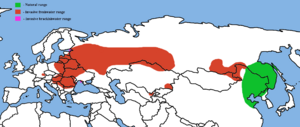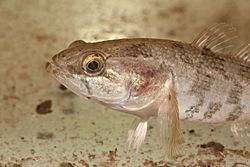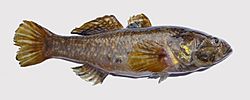Chinese sleeper facts for kids
Quick facts for kids Chinese sleeper |
|
|---|---|
 |
|
| Chinese sleeper in aquarium | |
| Scientific classification | |
 |
|
| The range of the Chinese sleeper (native in green; introduced in red) | |
| Synonyms | |
|
The Chinese sleeper (Perccottus glenii), also known as the Amur sleeper, is a species of freshwater sleeper native to Amur River basin in eastern Asia with introduced populations in other regions of Eurasia. It is currently the only known member of its genus.
Description
The Chinese sleeper, known as rotan in Russia, resembles a perch, ruffe or sculpin. The eyes are placed high on the head which has a rounded snout and projecting lower jaw. There is little or no gap between the two dorsal fins, the front one of which has six to eight spines and the back one nine to eleven soft rays. The anal fin has one to three spines and seven to ten soft rays. The pelvic fins are not fused together which helps to distinguish this fish from the gobies. The second dorsal and the anal fins are both more rounded and shorter than the gobies and the caudal fin is also more rounded. The general colour is brownish with a checker-board pattern of darker marks or dark barring. There are dark lines on the head radiating from the eye. This species can reach a length of 25 centimetres (9.8 in) TL and the greatest recorded weight for a specimen is 250 grams (8.8 oz).
Distribution and habitat
The Chinese sleeper is native to the Far East but appeared in ponds in Eastern Europe in the early twentieth century and has since spread to large parts of the Danube, the Vistula and other river basins where it is considered an invasive species. Its typical habitat is ponds, closed water-bodies and slow-moving streams. The westernmost locality of the Chinese sleeper range is the ponds in the Bavarian Danube basin in Germany. A finding in the mesohaline environment is registered in the North-Western Black Sea in Ukraine.
Invasiveness
In Europe, the Chinese sleeper is included since 2016 in the list of Invasive Alien Species of Union concern (the Union list). This implies that this species cannot be imported, bred, transported, commercialized, or intentionally released into the environment in the whole of the European Union. At least one case of monospecific fish community composed of Chinese sleeper is registered in Latvia.
Behaviour
The Chinese sleeper is an adaptable species and tolerant of widely different conditions. It feeds on insects and their larvae, small crustaceans and fish fry. It spawns in warm shallows among vegetation and the male guards the eggs.
Economic importance
This species is of minor importance to local commercial fisheries and has potential as an aquarium fish. However, introduced populations are of concern as they could become detrimental to the local fauna due to its predatory nature and voracious appetite.
See also
 In Spanish: Durmiente chino para niños
In Spanish: Durmiente chino para niños



